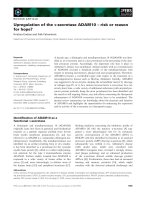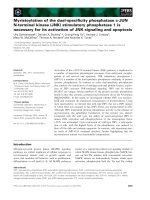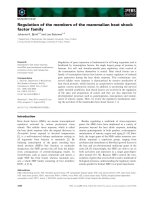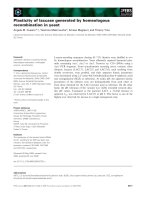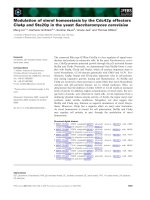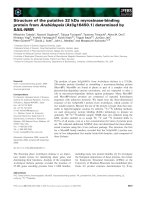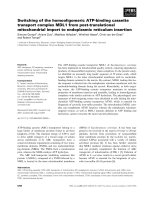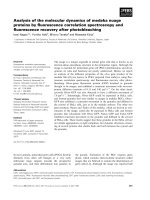Báo cáo khoa học: Inactivation of phosphorylase is a major component of the mechanism by which insulin stimulates hepatic glycogen synthesis doc
Bạn đang xem bản rút gọn của tài liệu. Xem và tải ngay bản đầy đủ của tài liệu tại đây (447.9 KB, 9 trang )
Inactivation of phosphorylase is a major component of the mechanism
by which insulin stimulates hepatic glycogen synthesis
Susan Aiston
1
, Matthew P. Coghlan
2
* and Loranne Agius
1
1
School of Clinical Medical Sciences, University of Newcastle upon Tyne, The Medical School, Newcastle upon Tyne, UK;
2
Department of Vascular Biology, GlaxoSmithKline, Harlow, Essex, UK
Multiple signalling pathways are involved in the mechanism
by which insulin stimulates hepatic glycogen synthesis. In
this study we used selective inhibitors of glycogen synthase
kinase-3 (GSK-3) and an allosteric inhibitor of phosphory-
lase (CP-91149) that causes dephosphorylation of phos-
phorylase a, to determine the relative contributions of
inactivation of GSK-3 and dephosphorylation of phos-
phorylase a as alternative pathways in the stimulation of
glycogen synthesis by insulin in hepatocytes.
GSK-3 inhibitors (SB-216763 and Li
+
) caused a greater
activation of glycogen synthase than insulin (90% vs. 40%)
but a smaller stimulation of glycogen synthesis (30% vs.
150%). The contribution of GSK-3 inactivation to insulin
stimulation of glycogen synthesis was estimated to be less
than 20%. Dephosphorylation of phosphorylase a with CP-
91149 caused activation of glycogen synthase and translo-
cation of the protein from a soluble to a particulate fraction
and mimicked the stimulation of glycogen synthesis by
insulin. The stimulation of glycogen synthesis by phos-
phorylase inactivation cannot be explained by either inhi-
bition of glycogen degradation or activation of glycogen
synthase alone and suggests an additional role for translo-
cation of synthase. Titrations with the phosphorylase inac-
tivator showed that stimulation of glycogen synthesis by
insulin can be largely accounted for by inactivation of
phosphorylase over a wide range of activities of phos-
phorylase a. We conclude that a signalling pathway invol-
ving dephosphorylation of phosphorylase a leading to both
activation and translocation of glycogen synthase is a critical
component of the mechanism by which insulin stimulates
hepatic glycogen synthesis. Selective inactivation of phos-
phorylase can mimic insulin stimulation of hepatic glycogen
synthesis.
Keywords: glycogen synthase kinase-3; glycogen synthesis;
insulin; liver; phosphorylase.
Insulin, glucose and amino acids are the major physio-
logical regulators of hepatic glycogen synthesis [1–3]. The
signalling pathways activated by insulin in hepatocytes
[3–7] bear similarities to the mechanisms identified in other
cell types [8,9]. Binding of insulin to the receptor causes
phosphorylation of insulin receptor substrates 1 and 2,
recruitment and activation of phosphatidylinositol
3-kinase, resulting in formation of phosphatidylinositol
3,4,5-trisphosphate, which causes recruitment of phospha-
tidylinositol-dependent kinase-1 to the plasma membrane
[8,9]. The latter enzyme phosphorylates and activates
protein kinase B, which in turn phosphorylates and
inactivates glycogen synthase kinase-3 (GSK-3). As GSK-
3 causes inactivation of glycogen synthase by phosphory-
lation at three sites, inactivation of GSK-3 allows glycogen
synthase to become activated by dephosphorylation.
Stimulation of glycogen synthesis by insulin in hepatocytes
is counteracted by inhibitors of phosphatidylinositol
3-kinase [4–6] and is associated with activation of protein
kinase B and inactivation of GSK-3 [5–7]. However, the
contribution of this signalling pathway to the stimulation
of glycogen synthesis by insulin in hepatocytes has not
been determined.
An alternative mechanism for regulation of glycogen
synthase is through changes in the concentration of
phosphorylase a, which inhibits glycogen synthase phos-
phatase activity [1] by binding to the C-terminus of the
glycogen targeting protein [10]. This protein was thought to
be present only in liver, but expression in human skeletal
muscle has also been reported [11]. Phosphorylase kinase
catalyses the conversion of inactive phosphorylase b into
active phosphorylase a by phosphorylation of a serine
residue at the N-terminus [1]. Metabolic conditions that
decrease the concentration of phosphorylase a through
either inhibition of phosphorylase kinase or activation of
phosphorylase phosphatase are expected to reverse the
inhibition of glycogen synthase phosphatase by phosphory-
lase a (Fig. 1). Dephosphorylation of phosphorylase a is
a component of the mechanism by which high glucose
concentration causes activation of glycogen synthase [1].
Binding of glucose to phosphorylase a makes the enzyme
a better substrate for phosphorylase phosphatase, and the
decrease in phosphorylase a reverses the inhibition of
glycogen synthase phosphatase [1].
Correspondence to L. Agius, School of Clinical Medical Sciences,
The Medical School, University of Newcastle upon Tyne,
Newcastle upon Tyne, NE2 4HH, UK.
Fax: + 44 191 2220723, Tel.: + 44 191 2227033,
E-mail:
Abbreviations: GSK-3, glycogen synthase kinase-3; MEM, minimum
essential medium; PTG, protein targeting to glycogen.
*Present address: Cardiovascular & Gastrointestinal Department,
AstraZeneca, Macclesfield, Cheshire SK10 4TG, UK.
(Received 21 March 2003, revised 30 April 2003, accepted 1 May 2003)
Eur. J. Biochem. 270, 2773–2781 (2003) Ó FEBS 2003 doi:10.1046/j.1432-1033.2003.03648.x
There is a long-standing debate as to whether inactivation
of phosphorylase is a component of the mechanism by
which insulin activates glycogen synthase in hepatocytes,
because inactivation of phosphorylase by insulin has been
observed in some but not other studies [3,6]. In freshly
isolated hepatocyte suspensions, sustained inactivation of
phosphorylase by insulin has generally been observed only
in the presence of glucagon or other counter-regulatory
hormones. However, this experimental model shows small
stimulatory effects of insulin on glycogen synthesis because
of the catabolic state of glycogen turnover [3]. Short-term
preculture of hepatocytes with dexamethasone allows
recovery from the catabolic state and restores a large
stimulatory effect of insulin on glycogen synthesis similar to
the stimulation that occurs in vivo [3]. The contribution of
phosphorylase inactivation to the stimulation of glycogen
synthesis by insulin in this experimental model has not been
tested.
Recently, several potent allosteric inhibitors of phos-
phorylase have been identified by high-throughput screens
[12–14]. Some of these compounds inhibit glycogenolysis in
hepatocytes by both allosteric inhibition of phosphorylase
and inactivation (conversion of phosphorylase a to b)
similar to glucose [14], whereas others inhibit glycogenolysis
exclusively by allosteric inhibition [15,16] or by inactivation
[16]. The latter compounds are very powerful experimental
tools to investigate the role of the phosphorylation state of
phosphorylase in metabolic control [12,17]. We demonstrate
in this study, using selective inhibitors of GSK-3 [18–20]
and a selective inhibitor of phosphorylase [12] that causes
dephosphorylation of phosphorylase a [16], that inactiva-
tion of GSK-3 in the absence of phosphorylase inactivation
is a small component of the mechanism by which insulin
stimulates hepatocyte glycogen synthesis. In contrast,
dephosphorylation of phosphorylase can mimic insulin
action and is a major component of the mechanism by
which insulin stimulates glycogen synthesis.
Materials and Methods
Materials
CP-91149 [12] and SB-216763 [18] were gifts from Pfizer
Global Research & Development, Groton Laboratories,
CT, USA, and SmithKline Beecham Pharmaceuticals,
Harlow, Essex, UK, respectively. The adenovirus vectors
for expression of wild-type GSK-3 and S9A-GSK-3 [21]
were kindly provided by M. Birnbaum, Howard Hughes
Medical Institute, University of Pennsylvania, Philadelphia,
PA, USA.
Hepatocyte isolation and cell culture
Hepatocytes were isolated by collagenase perfusion of the
liver of male Wistar rats (body weight 180–280 g) obtained
from B & K, Hull, UK [22]. They were suspended in
minimum essential medium (MEM) supplemented with 7%
(v/v) newborn calf serum, and plated in multiwell plates.
After cell attachment ( 4 h), the medium was replaced
with serum-free MEM containing 5 m
M
glucose and 10 n
M
dexamethasone, and the hepatocytes were cultured for
16–18 h [17].
Treatment of hepatocytes with recombinant
adenoviruses
At 2 h after plating, the hepatocytes were incubated for 2 h
in serum-free MEM without or with various titres of either
Fig. 1. Model showing two alternative mechanisms for the activation of hepatic glycogen synthase by insulin involving either inactivation of GSK-3
or inactivation of phosphorylase. Insulin phosphorylates and inactivates (–) GSK-3 by activation of protein kinase B (PKB). GSK-3 (+,
dephosphorylated form) phosphorylates and inactivates glycogen synthase (GS). Dephosphorylation (activation) of glycogen synthase (GS-b)
by synthase phosphatase (SP) is inhibited by phosphorylase a (Phos-a). Conversion of phosphorylase a into phosphorylase b (Phos-b) by
phosphorylase phosphatase (PP) is stimulated by glucose and by CP-91149. Insulin may convert phosphorylase a into phosphorylase b by
either inhibition of phosphorylase kinase (PK) or activation of phosphorylase phosphatase. This reverses the inhibition of synthase phosphatase
by phosphorylase a.
2774 S. Aiston et al.(Eur. J. Biochem. 270) Ó FEBS 2003
AdCMV-GSK-3 or AdCMV-S9A-GSK-3 for expression of
wild-type or mutant GSK-3, respectively [21]. The medium
was then replaced with serum-free MEM containing
dexamethasone, and the cells were cultured for 16–18 h
as above. Overexpression of GSK-3 was confirmed by
immunoblotting after 18 h of culture.
Incubations with insulin and inhibitors
After preculture for 16–18 h in MEM with dexametha-
sone, the medium was replaced with fresh MEM without
dexamethasone and with the substrates and inhibitors
indicated. Parallel incubations were performed for deter-
mination of glycogen synthesis, glycogen synthase and
phosphorylase a activity. For determination of glycogen
synthesis, hepatocyte monolayers were incubated for 3 h
in MEM containing [U-
14
C]glucose (2 lCiÆmL
)1
)andthe
glucose concentrations indicated. Inhibitors were dissolved
in dimethylsulfoxide, and control incubations contained
an equivalent volume (0.1%, v/v) of dimethylsulfoxide.
Radiolabelled glycogen was determined as described
previously [22]. Glycogen synthesis is expressed as nmol
of glucose incorporated into glycogenÆ3h
)1
Æ(mg cell pro-
tein)
)1
.
Enzyme assays and immunoblotting
At the end of the incubation, the plates were snap-
frozen in liquid nitrogen and stored at )80 °C until
assay. For determination of glycogen synthase, cells were
extracted as previously described [23], and assays were
performed on the whole homogenate (unless indicated
otherwise) or in the 13 000 g supernatant and pellet
fractions from the incorporation of UDP[6-
3
H]glucose
into glycogen in the absence or presence of 6.7 m
M
Glc6P, representing active and total glycogen synthase,
respectively [24]. Active glycogen synthase (– Glc6P) is
expressed either as mUÆ(mg protein)
)1
(nmolÆmin
)1
Æmg
)1
)
or as the activity ratio (– Glc6P/+ Glc6P). For deter-
mination of phosphorylase a, the hepatocytes were
extracted as described previously [17]. Phosphorylase a
was determined in the supernatant spectrometrically
by coupling to phosphoglucomutase and glucose-6-
phosphate dehydrogenase [23]. Phosphorylase a activity
is expressed as mUÆ(mg cell protein)
)1
(nmolÆ
min
)1
Æmg
)1
). GSK-3 was assayed as in [5]. Activity is
expressed as pmol
32
P incorporatedÆmin
)1
Æ(mg protein)
)1
.
Immunoblotting for glycogen synthase and GSK-3 was
performed after fractionation of the extracts by SDS/
PAGE. After transfer of the proteins to nitrocellulose,
the membrane was probed with a rabbit antibody to rat
liver glycogen synthase raised against residues IP
KGKKKLHGEYKN(690–703) [25] or a goat antibody
to GSK-3b (Santa Cruz, Santa Cruz, CA, USA)
followed by incubation with the appropriate peroxi-
dase-conjugated secondary antibody (Jackson Immuno-
research, West Grove, PA, USA). Immunoreactive
bands were visualized using an ECL kit (Amersham
Biotech).
Results are expressed as means ± SEM for the number
of hepatocyte preparations indicated. Statistical analysis
was by Student’s paired t test.
Results
Insulin causes rapid and sustained inactivation
of phosphorylase
When hepatocytes were precultured as described in Mate-
rials and Methods and then incubated in fresh MEM
without dexamethasone, insulin caused a rapid and sus-
tained decrease in the activity of phosphorylase a at both
5m
M
glucose (40% decrease) and 25 m
M
glucose (60%
decrease). The inactivation by insulin was observed within
15 min and had a similar time course at low and high
glucose (Fig. 2A). This contrasts with the activation of
Fig. 2. Time course of inactivation of phosphorylase a (A) and activa-
tion of glycogen synthase (B) by 10 n
M
insulin. Hepatocytes were
incubated with the glucose concentrations indicated for 4 h and with
10 n
M
insulin for the time intervals indicated. Values are means ±
SEM, n ¼ 4–6. *P < 0.05; **P < 0.005 inactivation by insulin
relative to control.
Ó FEBS 2003 Role of phosphorylase in insulin signalling (Eur. J. Biochem. 270) 2775
glycogen synthase by insulin, which was more rapid at
25 m
M
than at 5 m
M
glucose (Fig. 2B).
Inhibition of GSK-3 is less effective than insulin
at stimulating glycogen synthesis
Inactivation of GSK-3 by insulin in hepatocytes has been
demonstrated previously [5,6]. In this study we confirmed
that insulin inactivates GSK-3 (control, 0.21 ± 0.04;
10 n
M
insulin for 10 min, 0.14 ± 0.04, n ¼ 10, pmolÆ
min
)1
Æmg
)1
, P < 0.05). The inactivation by insulin (33%)
was less than the inactivation caused by calyculin A
(50 n
M
), a protein phosphatase inhibitor (0.025 ± 0.01,
88%, P < 0.05), indicating that insulin causes only partial
inactivation of GSK-3. To determine the role of GSK-3
inactivation in insulin action, we used the selective GSK-3
inhibitor SB-216763, an arylindolemaleimide [18]. SB-
216763 caused a concentration-dependent increase in the
activity ratio of glycogen synthase (Fig. 3A), in agreement
with previous findings on other cell types [18], and it had
no significant effect on the activity of phosphorylase a
(control, 7.0 ± 2.7; 10 l
M
SB-216763, 6.0 ± 2.1; 25 l
M
SB-216763, 5.8 ± 1.9, n ¼ 4, mUÆmg
)1
). When compared
with insulin, SB-216763 caused a larger activation of
glycogen synthase (93% vs. 40%, Fig. 3B) but a smaller
stimulation of glycogen synthesis (28% vs. 156%,
Fig. 3C). Similarly 10 m
M
Li
+
, a potent inhibitor of
GSK-3 [19,20], also caused a larger activation of glycogen
synthase (73% vs. 40%) but a smaller stimulation of
glycogen synthesis (28% vs. 156%) than insulin. In the
combined presence of insulin and either SB-216763 or Li
+
,
the activation of glycogen synthase was greater (P < 0.05)
than with GSK-3 inhibitors alone, indicating that insulin
activates glycogen synthase by mechanisms additional to
inactivation of GSK-3 (Fig. 3B), and it was significantly
(P < 0.05) greater than with insulin alone, consistent with
the partial inactivation of GSK-3 by insulin. The rates of
glycogen synthesis in the combined presence of GSK-3
inhibitors and insulin were the same as with insulin alone,
despite the further activation of glycogen synthase
(Fig. 3C).
Inactivation of phosphorylase mimics insulin
stimulation of glycogen synthesis
We used CP-91149, a potent selective inhibitor of phos-
phorylase [12] that causes conversion of phosphorylase a to
b in hepatocytes [16,17], to determine the role of dephos-
phorylation of phosphorylase in the regulation of glycogen
synthesis. CP-91149 (2.5 l
M
) caused a similar stimulation of
glycogen synthesis and inactivation of phosphorylase to that
of insulin (Fig. 4). It is noteworthy that 1,4-dideoxy-1,4-
imino-
D
-arabinitol, an allosteric inhibitor of phosphorylase
[26] that does not cause dephosphorylation of phosphory-
lase a [16], does not stimulate glycogen synthesis [15]. This
was confirmed in parallel incubations in the present study
(results not shown), indicating that stimulation of glycogen
synthesis by CP-91149 is due to dephosphorylation of
phosphorylase a rather than inhibition of glycogen degra-
dation or cycling.
Fig. 3. Effects of insulin and GSK-3 inhibitors on glycogen synthase and glycogen synthesis. Hepatocytes were incubated for 3 h in MEM containing
10 m
M
glucose and the additions indicated. (A) Activation of glycogen synthase by various concentrations of SB-216763. (B) and (C) Effects of
25 l
M
SB-216763 or 10 m
M
LiCl in the absence (open bars) or presence (closed bars) of 10 n
M
insulin on the activity of glycogen synthase and rates
of glycogen synthesis. Incubation mixtures for determination of glycogen synthesis contained [U-
14
C]glucose as described in Materials and
methods. The total activity of glycogen synthase assayed in the presence of Glc6P was 1.05 ± 0.16 (A) and 0.94 ± 0.14 (B) mUÆmg
)1
and was not
affected by the incubation conditions tested. Values are means ± SEM, n ¼ 4. *P < 0.05 relative to no insulin; #P < 0.05 relative to no inhibitor.
2776 S. Aiston et al.(Eur. J. Biochem. 270) Ó FEBS 2003
Stimulation of glycogen synthesis but not activation
of glycogen synthase by insulin can be explained
by inactivation of phosphorylase
To determine the role of inactivation of phosphorylase in
the stimulation of glycogen synthesis by insulin, we
determined the combined effects of insulin and various
concentrations of CP-91149. The effects of insulin on
phosphorylase inactivation, glycogen synthase activation
(Fig. 5A), and stimulation of glycogen synthesis (Fig. 5B)
were significant at all concentrations of inhibitor tested
(P < 0.05). When the activity of glycogen synthase was
plotted against the respective activity of phosphorylase a,
the curves for untreated (control) and insulin-treated
incubations were not superimposed (Fig. 5C), indicating
that activation of glycogen synthase by insulin cannot be
fully explained by inactivation of phosphorylase. However,
the corresponding curves for glycogen synthesis against
phosphorylase a (Fig. 5D) in the absence and presence of
insulin were superimposed over a wide range of activities of
phosphorylase down to 40% of basal activity. This indicates
that insulin stimulates glycogen synthesis predominantly by
inactivation of phosphorylase over the range 3–7 mUÆmg
)1
but also by additional mechanisms at activities below
3mUÆmg
)1
.
The stimulation of glycogen synthesis by insulin and
phosphorylase inactivation are greater than can be
explained by activation of glycogen synthase
In view of the above findings that inactivation of
phosphorylase mimics insulin stimulation of glycogen
synthesis (Figs 4 and 5), whereas inactivation of GSK-3
has only a small stimulatory effect despite the large activation
of glycogen synthase (Fig. 3), we tested the relative roles of
GSK-3 and phosphorylase a inthesameexperimentsby
modulating GSK-3 activity by adenovirus-mediated expres-
sion of wild-type GSK-3 or a constitutively active mutant
(S9A-GSK-3) [21,27] or by inhibiting GSK-3 activity with
SB-216763 (Fig. 6). Incubations for determination of glyco-
gen synthesis were performed in the absence or presence of
insulin or CP-91149, and rates of glycogen synthesis were
expressed relative to the corresponding activity of glycogen
synthase (assayed in the absence of Glc6P).
In the absence of insulin or CP-91149, the relation
between the rate of glycogen synthesis and the activity of
glycogen synthase was sigmoidal (Fig. 6, solid line). In
cells expressing endogenous GSK-3, the rate of glycogen
synthesis was at or near the plateau of the sigmoidal curve.
The GSK-3 inhibitor caused a twofold increase in the
activity of glycogen synthase, but had little effect on flux.
Conversely, GSK-3 overexpression caused a marked
decrease in both the activity of glycogen synthase and the
rate of glycogen synthesis. Both insulin (dashed line) and
CP-91149 (dotted line) caused an upward shift in the
glycogen synthesis versus glycogen synthase curve, indica-
ting that stimulation of glycogen synthesis cannot be
explained by activation of glycogen synthase alone.
Inactivation of phosphorylase causes translocation
of glycogen synthase
To test for other mechanisms that might explain the
stimulation of glycogen synthesis by phosphorylase inacti-
vation, we determined the effects of CP-91149 on the
subcellular distribution of glycogen synthase. Previous
studies showed that high glucose concentration causes
translocation of glycogen synthase from a soluble to a
particulate fraction by a Glc6P-dependent mechanism [28].
We therefore determined the distribution of glycogen
synthase total activity (assayed in the presence of Glc6P)
or protein (by immunoblotting), between the supernatant
and particulate fractions in cells treated with CP-91149 or
various concentrations of glucose and insulin. CP-91149
caused translocation of glycogen synthase from the super-
natant to the particulate fraction, as shown by immuno-
blotting (Fig. 7A) or the radiochemical assay (Fig. 7B),
similar to the combined effect of 25 m
M
glucose and insulin
(Fig. 7B). As phosphorylase a andglycogensynthasebind
to the glycogen targeting protein (PTG) by a mutually
exclusive mechanism [29,30], we tested for the presence of
PTG in the particulate fraction. Immunoreactivity to PTG
Fig. 4. Effects of insulin and CP-91149 on phosphorylase a (A) activity
and glycogen synthesis (B) at various glucose concentrations. Hepato-
cytes were incubated for 3 h with the glucose concentrations indicated
in the absence (s) or presence of 10 n
M
insulin (j)or2.5l
M
CP-91149 (m). Values are means ± SEM, n ¼ 4. Effects of insulin and
CP-91149 were significant (P < 0.05) at all concentrations of glucose.
Ó FEBS 2003 Role of phosphorylase in insulin signalling (Eur. J. Biochem. 270) 2777
(at 36 kDa) was detected in both supernatant and the
particulate fractions (results not shown).
Discussion
Inactivation of GSK-3 is considered to be a key component
of the mechanism by which insulin stimulates glycogen
synthesis [8,9]. However, the quantitative contribution of
this mechanism compared with other signalling pathways to
the stimulation of glycogen synthesis by insulin has not
been evaluated. In this study we used selective inhibitors of
GSK-3 [18–20] and a selective inhibitor of phosphorylase
that causes dephosphorylation of the enzyme [12,16] to
determine the contributions of inactivation of GSK-3 and
dephosphorylation of phosphorylase to the mechanism by
which insulin stimulates glycogen synthesis in liver cells.
Three key conclusions can be drawn: (a) that inactivation of
phosphorylase is an essential component of the mechanism
by which insulin stimulates glycogen synthesis and it can
account for the stimulation of glycogen synthesis by insulin
over a wide range of activities of phosphorylase a;(b)that
suppression of GSK-3 activity, in the absence of inactiva-
tion of phosphorylase, causes a large activation of glycogen
synthase but a small stimulation of glycogen synthesis; (c)
that the stimulation of glycogen synthesis by inactivation of
phosphorylase is associated with both activation and
translocation of glycogen synthase, and that the former
mechanism alone cannot explain the stimulation of glyco-
gen synthesis. This suggests that translocation of glycogen
synthase may be an essential component of the mechanism
by which dephosphorylation of phosphorylase leads to
stimulation of glycogen synthesis.
GSK-3 inactivation has been implicated in the mechan-
ism by which insulin stimulates glycogen synthesis on the
basis of three pieces of evidence. First, inactivation of GSK-3
by insulin occurs in several cell types [8,9]. Second, GSK-3
causes phosphorylation and inactivation of glycogen syn-
thase whereas inhibition of GSK-3 in intact cells causes
activation of glycogen synthase [21]. Third, overexpression
of a constitutively active GSK-3 mutant overrides the
activation of glycogen synthase [27] and stimulation of
glycogen synthesis caused by insulin in adipocytes [21]. In
the present study a clear role for GSK-3 in the regulation of
glycogen synthase has been demonstrated by overexpression
Fig. 5. Stimulation of glycogen synthesis but not activation of glycogen synthase by insulin can be largely explained by inactivation of phosphorylase.
Hepatocytes were incubated for 3 h with 15 m
M
glucose and the concentrations of CP-91149 indicated in either the absence (open symbols) or
presence (closed symbols) of 10 n
M
insulin. (A) Phosphorylase a and active glycogen synthase (– Glc6P) expressed as mUÆ(mg protein)
)1
.(B)
Glycogen synthesis. (C) Active glycogen synthase vs. phosphorylase a. (D) Glycogen synthesis vs. phosphorylase a. Values are means ± SEM,
n ¼ 4.
2778 S. Aiston et al.(Eur. J. Biochem. 270) Ó FEBS 2003
of wild-type or S9A-GSK-3, which caused marked inacti-
vation of glycogen synthase, and by the GSK-3 inhibitors,
which caused twofold activation of glycogen synthase. The
greater activation of glycogen synthase by GSK3 inhibitors
(90%) compared with insulin (40%) can be explained by the
small fractional inactivation of GSK-3 caused by insulin
(33%). Whereas inactivation of glycogen synthase by GSK-3
overexpression resulted in inhibition of glycogen synthesis,
activation of glycogen synthase by GSK-3 inhibition had
little effect on glycogen synthesis. This is explained by
the sigmoidal relation between glycogen synthesis and
glycogen synthase activity at endogenous activities of
phosphorylase a. Thus GSK-3 inactivation in the absence
of inactivation of phosphorylase had little impact on flux
through glycogen synthesis in hepatocytes, despite activa-
tion of glycogen synthase. Accordingly the inactivation of
GSK-3 caused by insulin accounted for less than 20% of the
stimulation of glycogen synthesis. The additive activation of
glycogen synthase by insulin and GSK-3 inhibitors indicates
that insulin activates glycogen synthase by mechanisms
additional to inactivation of GSK-3. This can be explained,
at least in part, by the inactivation of phosphorylase by
insulin.
Two pieces of evidence from the studies with the
phosphorylase inhibitor (CP-91149) support a role for
dephosphorylation of phosphorylase a as a critical compo-
nent of the mechanism by which insulin stimulates glycogen
synthesis. In the absence of insulin, the phosphorylase
inhibitor CP-91149 caused a dose-dependent stimulation of
glycogen synthesis that exceeded the stimulation caused by
insulin, at concentrations of inhibitor that inactivated
phosphorylase a by 85%. This stimulation of glycogen
synthesis cannot be explained by inhibition of glycogen
degradation or by a decrease in catalytic activity of
phosphorylase, because it is not mimicked by another
selective inhibitor of phosphorylase that inhibits glucagon-
stimulated glycogenolysis [15,16] but does not cause
dephosphorylation of phosphorylase a [16]. This lack of
stimulation of glycogen synthesis by an allosteric inhibitor
of phosphorylase [15,31] is further evidence against cycling
between glycogen synthesis and degradation as shown also
in other in vitro models [32]. The stimulation of glycogen
synthesis by CP-91149 also cannot be explained by
nonspecific effects on glucose metabolism because the
Fig. 6. Relation between glycogen synthesis and active glycogen syn-
thasedeterminedbymodulationofGSK-3activitybyGSK-3overex-
pression or inhibition. (A) GSK-3b was determined by immunoblotting
of hepatocytes that were either untreated (End) or treated with wild-
type AdCMV-GSK-3 (w) or mutant AdCMV-S9A-GSK-3 (m) and
cultured for 18 h. (B) Hepatocytes were either untreated (open sym-
bols) or treated (closed symbols) with AdCMV-GSK-3 (w) or AdC-
MV-S9A-GSK-3 (m). After 18 h of culture, they were incubated for
3 h in medium containing 10 m
M
glucose without (s,d)orwith10 n
M
insulin (h,j)or2.5l
M
CP-91149 (n,m) for determination of glyco-
gen synthesis and active glycogen synthase (– Glc6P). Where indicated
(Inh), 25 l
M
SB-216763 was added during the 3 h incubation to inhibit
GSK-3 activity. Glycogen synthesis is plotted against the respective
glycogen synthase activity. Values are means ± SEM, n ¼ 4.
Fig. 7. Inactivation of phosphorylase causes translocation of glycogen
synthase. Hepatocytes were incubated for 60 min with 5 m
M
glucose
(A) or the glucose concentrations indicated (B) without (Con) or with
10 l
M
CP-91149 (CP) or 10 n
M
insulin (Ins). The cell homogenates
were centrifuged at 13 000 g, and total glycogen synthase (GS) was
determined in the supernatant (SN) and pellet (P) fractions by
immunoblotting (A) or radiochemically (B). (A) Immunoblot and
corresponding densitometry. (B) Total glycogen synthase activity
(assayed in the presence of Glc6P) in the pellet as a percentage of
supernatant plus pellet activity. Values are means ± SEM, n ¼ 3.
Ó FEBS 2003 Role of phosphorylase in insulin signalling (Eur. J. Biochem. 270) 2779
compound had no effect on glucose phosphorylation,
glycolysis, or the Glc6P content of hepatocytes [17]. The
stimulation of glycogen synthesis by CP-91149 therefore
shows that inactivation (dephosphorylation) of phosphory-
lase can mimic the stimulatory effect of insulin.
In the experiments in which the effects of insulin on
glycogen synthase and synthesis were tested in the presence
of various concentrations of the phosphorylase inhibitor
and expressed relative to the respective activity of phos-
phorylase a, the stimulation of glycogen synthesis but not
the activation of glycogen synthase could be largely
accounted for by inactivation of phosphorylase over a wide
range of activities of phosphorylase a (> 3 mUÆmg
)1
).
These findings are in agreement with the high flux control
coefficient of phosphorylase on glycogen synthesis [17] and
with the GSK-3 inhibitor studies that show a sigmoidal
relation between glycogen synthesis and glycogen synthase
activity, with a basal rate of flux at or near the plateau.
The phosphorylase inactivator, CP-91149, caused both
activation of glycogen synthase and translocation of the
enzyme to the pellet. Previous studies have shown that high
glucose concentration causes translocation of glycogen
synthase in hepatocytes to the cell periphery [25] and from
the supernatant to the particulate fraction [28]. This effect of
glucose is abolished by inhibition of glucose phosphoryla-
tion and correlates with the accumulation of Glc6P [28],
suggesting a role for Glc6P in translocation of glycogen
synthase. However, in some metabolic conditions, translo-
cation of glycogen synthase does not correlate with Glc6P
[33]. Two explanations are possible. Either there is subcel-
lular compartmentation of Glc6P [34] or additional mech-
anisms may be involved in mediating translocation of
glycogen synthase. CP-91149 does not affect the Glc6P
content of hepatocytes [17]. Although we cannot rule out
subcellular changes in the concentration of Glc6P in the
presence of the phosphorylase inactivator, we suggest that
additional factors may be involved in translocation of
glycogen synthase and that phosphorylase a itself may be an
important determinant of the subcellular compartmentation
of glycogen synthase through competitive binding to a
common targeting protein. PTG [29] has a binding site at
the C-terminus, which binds phosphorylase a and glycogen
synthase by a mutually exclusive mechanism [30]. If the
binding affinity of PTG is greater for phosphorylase a than
for phosphorylase b, then dephosphorylation of phosphory-
lase a may favour binding of glycogen synthase. Overex-
pression of PTG in hepatocytes activates glycogen synthase
and stimulates glycogen synthesis [35,36]. As the twofold
activation of glycogen synthase by inhibition of GSK-3 has a
negligible effect on glycogen synthesis (this study), the
stimulation of glycogen synthesis by PTG overexpression
could be explained by either combined activation of glycogen
synthase and inactivation of phosphorylase [35] or combined
activation of glycogen synthase and translocation or binding
to PTG. The hypothesis that inactivation of phosphorylase
by CP-91149 or insulin may cause binding of glycogen
synthase to glycogen targeting proteins remains to be tested.
Until now, studies on insulin signalling in relation to
glycogen synthesis have largely focused on mechanisms
leading to activation of protein kinase B and inactivation of
GSK-3. We demonstrate in this study that inactivation of
phosphorylase but not inhibition of GSK-3 mimics insulin
stimulation of glycogen synthesis in hepatocytes and that
insulin action on glycogen synthesis can be largely accoun-
ted for by phosphorylase inactivation. Accordingly, studies
on insulin signalling should address the mechanism that
leads to dephosphorylation of phosphorylase. In hepatocyte
suspensions incubated in the absence of amino acids, insulin
activates protein kinase B but does not activate glycogen
synthase, suggesting that activation of protein kinase B
alone is not sufficient to elicit the anabolic effects of insulin
[37]. On the basis of the present findings that inactivation of
phosphorylase is essential for stimulation of glycogen
synthesis by insulin and it is also a contributing factor to
the activation of glycogen synthase, the question could be
raised whether medium amino acids are either essential for,
or have a permissive role in mediating, the inactivation of
phosphorylase by insulin?
Acknowledgements
This work was supported by Diabetes UK and by the Medical
Research Council. We thank Dr Morris Birnbaum for the gift of GSK-3
adenoviruses, Drs Joan Guinovart and Rez Halse for the antibodies to
glycogen synthase a and PTG, respectively, and Dr Judith Treadway
for CP-91149 and helpful advice.
References
1. Bollen, M., Keppens, S. & Stalmans, W. (1998) Specific features of
glycogen metabolism in liver. Biochem. J. 336, 19–31.
2. Meijer, A.J., Baquet, A., Gustafson, L., van Woerkom, G. M. &
Hue, L. (1992) Mechanism of activation of liver glycogen synthase
by swelling. J. Biol. Chem. 267, 5823–5828.
3. Agius, L., Alam, N. & Aiston, S. (2000) Short-term regulation by
insulin of glucose metabolism in isolated and cultured hepatocytes.
In The Hepatocyte Review (Berry, M.N. & Edwards A.M., eds),
pp. 317–341. Kluwer Academic Publishers, Dordrecht,
the Netherlands.
4. Carlsen, J., Christiansen, K. & Vinten, J. (1997) Insulin stimulated
glycogen synthesis in isolated rat hepatocytes: effect of protein
kinase inhibitors. Cell Signal. 9, 447–450.
5. Peak, M., Rochford, J.J., Borthwick, A.C., Yeaman, S.J. & Agius,
L. (1998) Signalling pathways involved in the stimulation of
glycogen synthesis by insulin in rat hepatocytes. Diabetologia 41,
16–25.
6. Lavoie, L., Band, C.J., Kong, M., Bergeron, J.M. & Posner, B.I.
(1999) Regulation of glycogen synthase in rat hepatocytes.
Evidence for multiple signaling pathways. J. Biol. Chem. 274,
28279–28285.
7. Walker, K.S., Deak, M., Paterson, A., Hudson, K., Cohen, P. &
Alessi, D.R. (1998) Activation of protein kinase B beta and
gamma isoforms by insulin in vivo and by 3-phosphoinositide-
dependent protein kinase-1 in vitro: comparison with protein
kinase B alpha. Biochem. J. 331, 299–308.
8. Vanhaesebroeck, B. & Alessi, D.R. (2000) The PI3K-PDK1
connection: more than just a road to PKB. Biochem. J. 346,
561–576.
9. Saltiel, A.R. & Kahn, C.R. (2001) Insulin signaling and regulation
of glucose and lipid metabolism. Nature (London) 414, 799–806.
10. Armstrong, C.G., Doherty, M.J. & Cohen, P.T. (1999) Identifi-
cation of the separate domains in the hepatic glycogen-targeting
subunit of protein phosphatase-1 that interact with phosphorylase
a, glycogen and protein phosphatase 1. Biochem. J. 336, 699–704.
11. Munro, S., Cuthbertson, D.J.R., Cunningham, J., Sales, M. &
Cohen, P.T.W. (2002) Human skeletal muscle expresses a
2780 S. Aiston et al.(Eur. J. Biochem. 270) Ó FEBS 2003
glycogen targeting subunit of PP1 that is identical to the
insulin-sensitive glycogen targeting subunit of liver. Diabetes
51, 591–598.
12. Martin, W.H., Hoover, D.J., Armento, S.J., Stock, I.A.,
McPherson,R.R.,Danley,D.E.,Stevenson,R.W.,Barrett,E.J.&
Treadway, J.L. (1998) Discovery of a human glycogen phos-
phorylase inhibitor that lowers blood glucose in vivo. Proc. Natl
Acad. Sci. 95, 1776–1781.
13. Treadway, J.L., Mendys, P. & Hoover, D.L. (2001) Glycogen
phosphoryase inhibitors for treatment of type 2 diabetes mellitus.
Exp. Opin. Invest. Drugs 10, 439–454.
14. Bergans, N., Stalmans, W., Goldman, S. & Vanstapel, F. (2000)
Molecular mode of inhibition of glycogenolysis in rat liver by
the dihydropyridine derivative BAY R3401. Inhibition and
inactivation of glycogen phosphorylase by an activated
metabolite. Diabetes 49, 1419–1426.
15. Andersen, B., Rassov, A., Westergaard, N. & Lundgren, K. (1999)
Lundgren K: inhibition of glycogenolysis in primary rat hepato-
cytes by 1,4-dideoxy-1,4-imino-
D
-arabinitol. Biochem. J. 342,
545–550.
16. Latsis, T., Andersen, B. & Agius, L. (2002) Diverse effects of two
allosteric inhibitors on the phosphorylation state of phosphorylase
in hepatocytes. Biochem. J. 368, 309–316.
17. Aiston, S., Hampson, L., Gomez-Foix, A.M., Guinovart, J.J. &
Agius, L. (2001) Hepatic glycogen synthesis is highly sensitive to
phosphorylase activity: evidence from metabolic control analysis.
J. Biol. Chem. 276, 23856–23866.
18. Coghlan, M.P., Culbert, A.A., Cross, D.A., Corcoran, S.L.,
Yates,J.W.,Pearce,N.J.,Rausch,O.L.,Murphy,G.J.,Carter,
P.S., Cox, L., Mills, D., Brown, M.J., Haigh, D., Ward, R.W.,
Smith,D.G.,Murray,K.J.,Reith,A.D.&Holder,J.C.(2000)
Selective small molecule inhibitors of glycogen synthase kinase-3
modulate glycogen metabolism. Chem. Biol. 7, 793–803.
19. Klein, P.S. & Melton, D.A. (1996) A molecular mechanism for the
effect of lithium on development. Proc.NatlAcad.Sci.USA93,
8455–8459.
20. Stambolic, V., Ruel, L. & Woodgett, J.R. (1996) Lithium inhibits
glycogen synthase kinase-3 activity and mimics wingless signalling
in intact cells. Curr. Biol. 6, 1664–1668.
21. Summers, S.A., Kao, A.W., Kohn, A.D., Backus, G.S., Roth,
R.A., Pessin, J.E. & Birnbaum, M.J. (1999) The role of glycogen
synthase kinase-3 beta in insulin-stimulated glucose metabolism.
Biol. Chem. 274, 17934–17940.
22. Agius, L., Peak, M. & Alberti, K.G.M.M. (1990) Regulation of
glycogen synthesis from glucose and gluconeogenic precursors
in periportal and perivenous rat hepatocytes. Biochem. J. 266,
91–102.
23. Aiston, S. & Agius, L. (1999) Leptin enhances glycogen storage in
hepatocytes by inhibition of phosphorylase and exerts an additive
effect with insulin. Diabetes 48, 15–20.
24. Thomas, J.A., Schlender, K.K. & Larner, J. (1968) A rapid filter
paper assay for UDP-glucose-glycogen glucosyltransferase,
including an improved biosynthesis of UDP
14
C-glucose. Anal.
Biochem. 25, 486–499.
25. Garcia-Rocha, M., Roca, A., De La Iglesia, N., Baba, O.,
Fernandez-Novell, J.M., Ferrer, J.C. & Guinovart, J.J. (2001)
Intracellular distribution of glycogen synthase and glycogen
in primary cultured rat hepatocytes. Biochem. J. 357, 17–24.
26. Fosgerau, K., Westergaard, N., Quistorff, B., Grunnet, N.,
Kristiansen, M. & Lundgren, K. (2000) Kinetic and functional
characterization of 1,4-dideoxy-1,4-imino-
D
-arabinitol: a potent
inhibitor of glycogen phosphorylase with anti-hyperglycaemic
effect in ob/ob mice. Arch. Biochem. Biophys. 380, 274–284.
27. Eldar-Finkelman, H., Argast, G.M., Foord, O., Fischer, E.H. &
Krebs, E.G. (1996) Expression and characterization of glycogen
synthase kinase-3 mutants and their effect on glycogen synthase
activity in intact cells. Proc. Natl Acad. Sci. USA 93, 10228–10223.
28. Fernandez-Novell, J.M., Arino, J., Vilaro, S., Bellido, D. &
Guinovart, J.J. (1992) Role of glucose 6-phosphate in the trans-
location of glycogen synthase in rat hepatocytes. Biochem. J. 288,
497–501.
29. Printen, J.A., Brady, M.J. & Saltiel, A.R. (1997) PTG a protein
phosphatase-1 binding protein with a role in glycogen metabolism.
Science 275, 1475–1478.
30. Fong, N.M., Jensen, T.C., Shah, A.S., Parekh, N.N., Saltiel, A.R.
& Brady, M.J. (2000) Identification of binding sites on protein
targeting to glycogen for enzymes of glycogen metabolism. J. Biol.
Chem. 275, 35034–35039.
31. Fosgerau, K., Breinholt, J., McCormack, J.G. & Westergaard, N.
(2002) Evidence against glycogen cycling of gluconeogenic
substrates in various liver preparations. J. Biol. Chem. 277,
28648–28655.
32. Grunnet, N., Jensen, S. & Dich, J. (1993) Absence of glycogen
cycling in cultured rat hepatocytes. Arch. Biochem. Biophys. 309,
18–23.
33. Seoane, J., Gomez-Foix, A.M., O’Doherty, R.M., Gomez-Ara,
C., Newgard, C.B. & Guinovart, J.J. (1996) Glucose 6-phosphate
produced by glucokinase, but not hexokinase I, promotes
the activation of hepatic glycogen synthase. J. Biol. Chem. 271,
23756–23760.
34. Gomis, R.R., Favre, C., Garcia-Rocha, M., Fernandez-Novell,
J.M., Ferrer, J.C. & Guinovart, J.J. (2003) Glucose 6-phosphate
produced by gluconeogenesis and by glucokinase is equally
effective in activating hepatic glycogen synthase. J. Biol. Chem.
278, 9740–9646.
35. Berman, H.K., O’Doherty, R.M., Anderson, P. & Newgard, C.B.
(1998) Overexpression of protein targeting to glycogen (PTG) in
rat hepatocytes causes profound activation of glycogen synthesis
independent of normal hormone- and substrate-mediated reg-
ulatory mechanisms. J. Biol. Chem. 273, 26421–26425.
36. Gasa, R., Jensen, P.B., Berman, H.K., Brady, M.J., DePaoli-
Roach, A.A. & Newgard, C.B. (2000) Distinctive regulatory and
metabolic properties of glycogen-targeting subunits of protein
phosphatase-1 (PTG, GL, GM/RGl) expressed in hepatocytes.
J. Biol. Chem. 275, 26396–26403.
37. Krause,U.,Bertrand,L.,Maisin,L.,Rosa,M.&Hue,L.(2002)
Signalling pathways and combinatory effects of insulin and amino
acids in isolated rat hepatocytes. Eur. J. Biochem. 269, 3742–3750.
Ó FEBS 2003 Role of phosphorylase in insulin signalling (Eur. J. Biochem. 270) 2781


